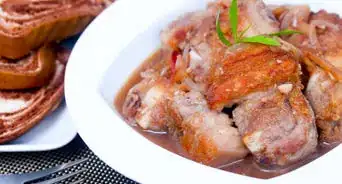This article was co-authored by wikiHow Staff. Our trained team of editors and researchers validate articles for accuracy and comprehensiveness. wikiHow's Content Management Team carefully monitors the work from our editorial staff to ensure that each article is backed by trusted research and meets our high quality standards.
The wikiHow Culinary Team also followed the article's instructions and verified that they work.
This article has been viewed 49,591 times.
Learn more...
Gammon isn't a food that you should only make at Christmas. You can easily make it at any time of the year. After you've cooked it, you can use it for sandwiches or other meals for a few days. To make gammon at home, you can boil it in tonic water or in tap water with a mix of onion, lemon, and black pepper.
Ingredients
Makes 6 servings
- 1 gammon joint
- Tap water
- 1 litre (0.26 US gal) of tonic water
- Cauliflower
- Potatoes
Makes 8 servings
- 1 gammon joint
- Fresh water or tap water
- Onion
- Lemon
- 1 tsp (10 g) of black pepper
- Potatoes
- Peas
- Cauliflower
Steps
Boiling Gammon with Tonic Water
-
1Boil your gammon for 10 minutes. Put your gammon in a large saucepan. Add tap water to the pan until the gammon is completely covered. Place the saucepan on the stove and bring it to a boil. Let it boil for 10 minutes.[1]
- Place a cover over the pan to trap the heat. Tilt the cover so that some steam or air can escape the pan. The cover will keep the heat in the pan and ensure that the gammon is properly boiled throughout.
-
2Take the pan off the stove after 10 minutes and get rid of the water. After 10 minutes in boiling water, your gammon will be well cooked. Take the cover off the pan and place it to the side. Use oven gloves to hold the sides of the pan. Slowly pour the water down the drain or sink.[2]
- You can also use the cover to keep the gammon in the pan and drain the water. Tilt it so the gammon can't fall out and leave the water drain out of the pan.
Advertisement -
3Cover the gammon with tonic water in the pan. Open the bottle and pour the tonic water straight into the pan on top of your gammon. Add enough tonic water to the pan so you completely cover the gammon.[3]
-
4Boil the water and then simmer it for between 1 and 3 hours. Once the water in your pan starts to bubble again, turn the heat on the stove down. Let the gammon simmer in the pan for 1 hour if it's small in size. If you have a very large amount of gammon, let it simmer for around 3 hours. The larger the gammon, the longer you can leave it simmer.[4]
- Small gammon is gammon between 200–400 grams (7.1–14.1 oz) in weight. Large gammon is anything above 700 grams (25 oz) in weight.
-
5Serve your gammon. After your gammon has finished simmering, it's ready for serving. Serve the gammon hot with potato, cauliflower, or other sides. You can also let the gammon go cold and make sandwiches with it for the next few days.[5]
- To store the gammon for another day, place it in the fridge in a container as soon as possible after your meal. Consume the gammon within 3 days of placing it in the fridge.
Making Boiled Gammon
-
1Weigh your gammon on a scale. Place your gammon on the weighing scales in your kitchen. Write down the weight of the gammon on a piece of paper. If you bought the gammon from a butcher and you asked for a certain amount, there's no need to weigh it.[6]
-
2Place the gammon in a large bowl of cold water overnight. This will get rid of the excess salt in the gammon. Soak the gammon in water for a few hours if you don't have the time to do it overnight.[7]
- If you don't have a few hours, boil the gammon for 30 minutes to get rid of the salt.
-
3Put the gammon in a saucepan with cold water and add ingredients. After you've removed the excess salt from the gammon, put in a large saucepan. Cover the gammon with cold water, either from the tap or a bottle.
- Add an onion, a lemon, and 1 tsp (10 g) of black pepper to enhance the taste of the gammon.
- Slowly bring the water to the boil after you've added the ingredients.
-
4Simmer the gammon for between 30 minutes and 1 hour. Smaller gammon, less than 500 grams (18 oz) in weight, should be simmered for 30 minutes. Larger gammon, heavier than 500 grams (18 oz), should be simmered for 1 hour.[8]
-
5Use a spoon or a ladle to remove any scum from the water. As the gammon simmers, some materials such as pieces of meat and fat will float to the top of the water. Remove these materials from the water. Try to take as little water as possible when using your spoon or ladle to remove these products.[9]
-
6Let the water and gammon cool for 10 minutes before taking it out. Drain the water into your sink first. The pan shouldn't be too hot to the touch, but wear oven gloves just in case. Once you've drained the water, take your gammon out of the pan.[10]
- If the skin is still on your gammon, peel it off before placing it on a plate to be served.
-
7Serve your gammon. If you want, you can drizzle sauces over your gammon for extra taste before you serve it. Gammon goes with a variety of flavors. When it's hot, add it to a dish with potatoes, peas, and cauliflower. Use it as a part of sandwiches when it's cold.[11]
- If you want to keep your gammon for leftovers, place it in a fridge as soon as possible. Consume it within 3 days of placing it in the fridge.
Things You'll Need
Boiling Gammon with Tonic Water
- Large saucepan
- Tap with cold water
- Stove
- Saucepan cover
Making Boiled Gammon
- Large saucepan
- Large bowl
- Ladle or spoon
- Stove
- Weighing scales
References
- ↑ http://allrecipes.co.uk/recipe/8837/sweet-boiled-gammon.aspx
- ↑ http://allrecipes.co.uk/recipe/8837/sweet-boiled-gammon.aspx
- ↑ http://allrecipes.co.uk/recipe/8837/sweet-boiled-gammon.aspx
- ↑ http://allrecipes.co.uk/recipe/8837/sweet-boiled-gammon.aspx
- ↑ http://allrecipes.co.uk/recipe/8837/sweet-boiled-gammon.aspx
- ↑ https://www.bbcgoodfood.com/howto/guide/how-cook-and-prepare-gammon-and-ham
- ↑ https://www.netmums.com/recipes/boiled-gammon
- ↑ https://www.bbcgoodfood.com/howto/guide/how-cook-and-prepare-gammon-and-ham
- ↑ https://www.bbcgoodfood.com/howto/guide/how-cook-and-prepare-gammon-and-ham




















































